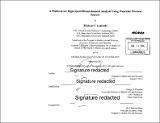| dc.contributor.advisor | Joseph A. Paradiso. | en_US |
| dc.contributor.author | Lapinski, Michael Tomasz | en_US |
| dc.contributor.other | Massachusetts Institute of Technology. Department of Architecture. Program in Media Arts and Sciences. | en_US |
| dc.date.accessioned | 2014-11-24T18:39:58Z | |
| dc.date.available | 2014-11-24T18:39:58Z | |
| dc.date.copyright | 2013 | en_US |
| dc.date.issued | 2013 | en_US |
| dc.identifier.uri | http://hdl.handle.net/1721.1/91852 | |
| dc.description | Thesis: Ph. D., Massachusetts Institute of Technology, School of Architecture and Planning, Program in Media Arts and Sciences, 2013. | en_US |
| dc.description | 116 | en_US |
| dc.description | Page 276 blank. Cataloged from PDF version of thesis. | en_US |
| dc.description | Includes bibliographical references (pages 263-275). | en_US |
| dc.description.abstract | Humanity's desire to capture and understand motion started in 1878 and has continually evolved. Today, the best-of- breed technology for capturing motion are marker based optical systems that leverage high speed cameras. While these systems are excellent at providing positional information, they suffer from an innate inability to accurately provide fundamental parameters such as velocity and acceleration. The problem is further compounded when the target of capture is high-speed human motion. When applied to biomechanical study, this inaccuracy is magnified when higher order parameters, such as torque and force, are calculated using optical information. This dissertation presents a a first-of-its-kind wearable dual-range inertial sensor platform that allows end-to-end investigation of high level biomechanical parameters. The platform takes a novel approach by providing these parameters more accurately and at a higher fidelity than the current state of the art.The dual-range sensing approach allows accurate capture of both slow-moving motion and rapid movement which pushes the limits of human ability. The platform addresses inherent problems with scaling clinical biomechanical analysis to tens-of-thousands of trials using the sensor platform's data. This end-to-end approach provides mechanisms for rapid player instrumentation, en masse data translation and calculation of clinically relevant joint forces and torques. I present design details for this platform along with kinematic testing and some early biomechanical insight gleamed from system measurements. | en_US |
| dc.description.statementofresponsibility | by Michael T. Lapinski. | en_US |
| dc.format.extent | 276 pages | en_US |
| dc.language.iso | eng | en_US |
| dc.publisher | Massachusetts Institute of Technology | en_US |
| dc.rights | M.I.T. theses are protected by copyright. They may be viewed from this source for any purpose, but reproduction or distribution in any format is prohibited without written permission. See provided URL for inquiries about permission. | en_US |
| dc.rights.uri | http://dspace.mit.edu/handle/1721.1/7582 | en_US |
| dc.subject | Architecture. Program in Media Arts and Sciences. | en_US |
| dc.title | A platform for high-speed biomechanical analysis using wearable wireless sensors | en_US |
| dc.type | Thesis | en_US |
| dc.description.degree | Ph. D. | en_US |
| dc.contributor.department | Program in Media Arts and Sciences (Massachusetts Institute of Technology) | |
| dc.identifier.oclc | 894253205 | en_US |
